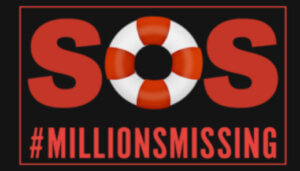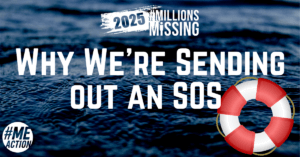UK charity Action for M.E. are this week hosting a social media campaign and its aim is to raise awareness of M.E. as a hidden illness among as wide an audience as possible, and to help people understand what having M.E. feels like. The all important message being, ‘there is a hidden face of M.E. I want you to see it.’
You can read all about the campaign HERE and if you do share the video (above) or indeed any of the associated blogs, then please don’t forget to use the hashtag #HiddenfacesofME on Facebook and Twitter. Indeed, in you use Twitter you can visit that hashtag and check out all the posts and comments this campaign is attracting.
Here are some of the blogs and films from those who have decided to participate. Please check them out and perhaps engage with the authors before sharing their stories on social media if you are able.
- Lorna Burford, on her Raindrops of Sapphire blog, who posted on Monday
- Olivia Cole, posting a film on her CFS Selfies YouTube channel, who also posted on Monday
- Emily Beardall, posting on her A Prescription for M.E., who posted on Tuesday
- Sam Livy, posting on her Facebook page every day when she is able
- Lizzie Guntrip, who was interviewed on BBC Radio Suffolk (@ 17mins 50secs) and will is also Tweeting all week
- Rosie Fletcher, who is posting on her Oh So Pleasant blog today
Additional updates can be found on the Action for M.E. Facebook page and Twitter feed. If you want to link your own work to the campaign you should get in touch with Action for M.E.
I hadn’t planned to actually participate in the campaign with a personal story, although I had said I would be more than happy to help promote it. But having read the other blogs, listened to the interview from Lizzie and watched the films, I changed my mind and have now had published something about my own personal struggles with M.E. You have been warned!
Can we do more?
An initiative like this one can of course continue beyond a week and indeed should. Many often do. Our stories can be powerful. But I was pondering yesterday just how much the blogs people write and the efforts we make to raise awareness actually reach let alone impact the world outside of this community. I think a concerted campaign like this one – shared widely enough on social media – does have the potential to reach the people that need to hear our stories and learn from our experience. People like those responsible for health, welfare, and research spending in Government, the medical establishment, existing ME/CFS specialist clinics, health commissioners, doctors and specialists, as well as ME/CFS experts; and of course our own families and friends.
Other recent efforts…
I was very impressed and inspired by an e-presentation from Sally Burch delivered to a conference at Queens University in Belfast last Saturday. This very expressive piece of work has been widely applauded on social media and rightly so. I think it demonstrates another way in which we might perhaps seek to influence decision-makers and those others in positions of power with our stories and wisdom. And while I don’t think I could measure up to that particular performance I certainly know people who’d be willing to lend a hand – and that’s what has been good about the internet; meeting other people with skills and abilities to share – and is especially great about ME Action Network.
Another and similar initiative to provide a platform for patients to tell their stories and reveal this often ‘Hidden face of M.E.’ has been wonderfully put together by The Solve ME/CFS Initiative in America with their Humans of ME/CFS website. The ultimate aim is to share our stories and help make the widespread devastation of M.E. very apparent and real to those who are in charge of research funding, in the hope that they will be less likely to overlook this community when it comes to that all important allocation of resources. I think it’s a great resource even if you do have your own blog and brings everyone’s stories together in one place which lends the effort even more power!
Of course writing and speaking about our own struggles with this disease or explaining what we want changed and improved doesn’t always have to be for some greater purpose. Writing and speaking bring their own benefits to the author in a personal way and it can be cathartic. It can also be a way to reach out to others in a similar situation and make contact – to share burdens and perhaps make friends. For such a very isolating illness it can be good to write, to talk, and to share.
Thank you to everyone for taking part in this particular campaign and for all that appears now online, and to those who do share the efforts of others, and in particular to those I mentioned above for their own particular initiatives. Also to ME Action Network for providing such a great platform where we can connect.
Take care
Russell Fleming (Twitter: @Firestormmer)






5 thoughts on “Hidden Faces of M.E.”
Thanks for sharing your personal story with us and for all the effort you make to share information and research with us, I appreciate it!
Thank you Sasha
I wish I was well enough to learn how to get on Facebook or Twitter etc. I am so thankful though to receive emails sharing videos and info. Of others living with ME/CFIDS. I’ve been ill since 1987 after being diagnosed with CMV virus. I have tried so many medications, some making me worse. I’m either bedridden, or homebound, with a few days a month when I can go out for awhile. I have been on this rollercoaster ride with ME for 28 years and have experienced so much loss. I now talk to a social worker to help me as my life has gone by and I have no support system. I loved helping and caring for others before I became ill, now I’m always alone. The hardest thing about ME is no one understands how hard it is to live with an illness no one wants to believe exists. It’s hurtful to hear negative remarks when we suffer. Many of the hidden faces of ME have the sunken eyes, pale faces that I have each time the fatigue overwhelms us . I just can’t understand why this illness is so ignored. All of you who are able to used social media to help ME recognized thank you. One doctor told me I didn’t have to worry about dying from CFS/ME , the truth is everyday for 28 years I’ve felt like I’ve been dying. Loved the music video of Olivia Cole on YouTube!
Thanks Marcia for taking the time and making the effort to reply
Some have compared this to a living death, and I think at times when it hits me hard and knocks me off of my pedestal I would certainly agree.
Even trying to manage now, the thought that – based on experience – I might again be hit by a relapse, means I am sub-consciously on the alert and that isn’t a comfortable way to live.
I loathe the fluctuating nature of this condition. Not being able to plan things or rely on things, and the relapsing-remitting course finally made me realise that I am likely to be stuck with this for life.
However, I do regard myself as fortunate. There are of course people – perhaps like yourself – who exist in a state of very severe ME for much longer periods than I ever did, and it is to those people that I think our maximum efforts should be addressed in terms of advocacy and research and treatment (when it comes).
But there are also a greater many people who are stuck in this twilight in-between world, who might be able to function better some of the time, but who are still held-back from fully partaking of life by their ME.
So I think that regardless of our individual state and abilities, we all remain connected and can never be certain that we won’t either move forward or fall back. And that’s what makes it tough – the continuing uncertainty.
My very best wishes
Russ
Yes Russ The constant uncertainty doesn’t help us at all, I truly agree. I’m always on alert not to do anything that may start another flare up. Living afraid is not healthy. My youngest son became ill last year and has now been diagnosed with ME. He just got married 2 years ago. He takes a medication I was able to take 28 years ago but eventually had to stop from side effects. It helps him now have less flare ups so he can hold onto his job, but he can no longer live an active life. I have been able to help him by encouraging him to not to push himself as I did. Hopefully it will prevent him from becoming worse like me. It has been so difficult seeing him become ill but I have hope that we will be heard and better treatments will be available for all who live with ME. Thanks for your kind reply.
Sincerely, Marcia
Comments are closed.